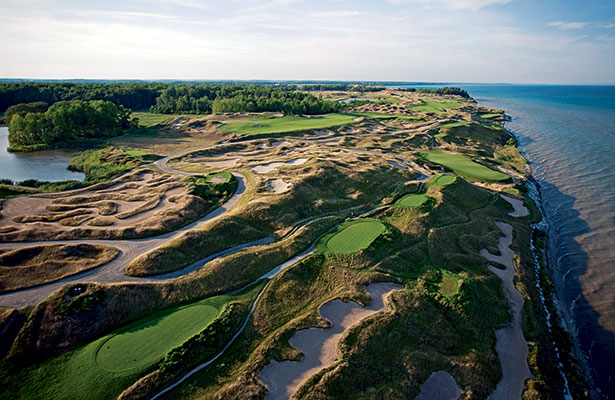As Whistling Straits hosts its third PGA Championship, Pete Dye’s unique creation still puts a scare into tour pros.
Has it really been 21 years since I first walked the site of what would become Whistling Straits? I still remember tagging alongside designer Pete Dye and course owner Herb Kohler on that strip of lakefront land 10 miles north of Sheboygan, Wis. Kohler had previously seen it only from the air, and it looked pretty lifeless from up there. That day, it seemed desolate from ground level, too. You had to possess the imagination of Dye to envision what would become, five years later, his greatest creation, the Straits Course.
I’m not saying Whistling Straits is Pete’s greatest course design of all time, even though it’s ranked 22nd on Golf Digest’s 2015-’16 list of America’s 100 Greatest Courses and is hosting its third PGA Championship since 2004. (It will also host the 2020 Ryder Cup.) Dye’s greatest design remains, in this golfer’s view, Teeth of the Dog in the Dominican Republic, where the routing—maximizing ocean frontage on eight holes and turning nine and 18 inland—Pete pretty much duplicated in laying out the Straits.

But Whistling Straits is certainly Dye’s greatest construction project of all time. This wasn’t a sow’s ear Pete turned into a deep-pocket silk purse for Kohler. It wasn’t even a strip of crispy bacon. It was as flat as a pancake that had been smushed by a steamroller. Tabletop flat. Linoleum-floor flat. It had potential to be a parking lot, maybe, but a world-class golf course? Not a chance.
It had been a two-mile-wide, half-mile- deep plateau above Lake Michigan that, during World War II, housed an Army air base called Camp Haven. Countless recruits took target practice from this high bluff, the shells dropping harmlessly into the lake. Then the camp closed, and Wisconsin Electric Co. bought it for a potential nuclear power plant. When that idea soured, Kohler scooped up the property, at Dye’s urging.
When we toured the site in 1994, a network of narrow roads crisscrossed the place. An overgrown runway stretched north and south along what is now the back nine. The only vertical structures were some old barracks and a couple of concrete-block ammunition bunkers. The only thing disturbing the monotony of the site was a deep, tree-lined ravine, which would ultimately become a hazard on nine and 18.
Dye took Kohler to play golf in Scotland and Ireland, and by the time they returned, Kohler was enthusiastic about Pete’s plan to turn Camp Haven into Ballybunion West. All that was needed was plenty of money and government permission. Rumors still abound that Kohler got preferential treatment for environmental permits from his buddies in the state and federal government, but what most critics don’t realize is that the old Army base was a toxic mess. Kohler spent $900,000 just to remove underground fuel tanks and remedy 27 illegal dump sites on the property.
What really made Whistling Straits work was a Corps of Engineers comment that the steep lakefront cliff was constantly eroding and needed stabilization. Dye asked if he could staircase holes from the shore. After a bureaucratic delay, they decided he could.
Voilà! Pete could perform his magic. Dye sliced the near-vertical shoreline by 45 degrees, used the fill to create massive dunes farther up top and produced a routing with multiple dimensions. Some greens, like the third, seventh and 12th, sit hunkered near the shoreline. Others, like those on the fourth, 13th and 17th, are positioned on cliffs offering rewards for risks and long-range vistas. Some tee boxes are on mounds six stories high. Other tees are below the fairway level. Fairways twist and turn, rise and fall, alongside and between jagged earthforms covered in shaggy fescues. A billion bunkers—or more precisely, 1,012 bunkers, by our actual count—are scattered about, each formed by Dye’s dozers and filled from one of 13,000 truckloads of sand brought in from elsewhere in the state.
Dye insists that environmental officials forced him to create the wetland ponds on the double-dogleg par-5 fifth hole, and though that is true, they didn’t force him to bracket the fairway with two separate ponds. That’s strictly a Dye concoction, one that’s hard on the average resort player but not those of tour caliber. In the last round of the 2010 PGA, Dustin Johnson eagled the 584-yard fifth by cutting the corner of the lake on his drive, then hitting a 9-iron over water for his second shot onto the green. If one seeks fireworks during this year’s PGA Championship, the fifth hole is the place to be. (It’s now 603 yards.)
Pete describes his style at Whistling Straits—with its pits and hollows, peaks and points—as “a grenade-attack look.” It’s a style that displeases most PGA Tour pros, who expect predictable bounces on their tee shots and approaches, and conventional conditions whenever faced with a recovery shot. A pro can play well at Whistling Straits and still dread it.
Consider Nick Watney, who led the 2010 PGA by three strokes after three rounds. That Saturday evening, he said of the Straits, “There are train wrecks everywhere.” The next day, he opened with a double bogey, suffered another double and even a triple en route to a 81, the worst score in the PGA by a 54-hole leader.
Yet we’ve completely forgotten his collapse because of an even greater train wreck by Dustin Johnson, who had the lead on the 72nd hole, grounded his clubhead in a footprint-laden bunker (“What bunker?” he later asked) and suffered a two-shot penalty that removed him from the three-hole playoff for the title. Martin Kaymer, playing the three holes in even par and won by one over Bubba Watson, who went off the rails with a double bogey on the final hole.
This year the bunker Johnson played from will be covered by a viewing grandstand. Otherwise, all of the course’s bunkers will be treated the same as in 2004 and 2010—hazards in which grounding a club will draw a penalty.
The Straits Course at Whistling Straits is Pete Dye’s greatest creation for two reasons. Its construction utilized all of Dye’s creative energy to produce a collection of distinctive and unique golf holes. What’s more, those holes mess with the heads of tour pros. They might say they don’t fear the Straits, but there is some trepidation on each tee. Every hole at Whistling Straits is a powder keg. As is befitting an old Army base.





